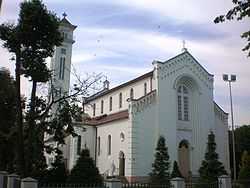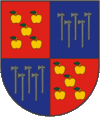Kybartai ( pronunciation (help·info)) is a city in the Marijampolė County, Lithuania. It is located 20 km (12 mi) west of Vilkaviškis and is on the border of Kaliningrad Oblast, Russia.
pronunciation (help·info)) is a city in the Marijampolė County, Lithuania. It is located 20 km (12 mi) west of Vilkaviškis and is on the border of Kaliningrad Oblast, Russia.
History
Kybartai was founded under the reign of Sigismund I the Old by the colonization efforts of his wife, Bona Sforza.
In 1561, it has been listed in the land-register of Jurbarkas and Virbalis.

Verzhbolovo Railway Station in Kybartai at about 1900
When in 1861 a branch of Saint Petersburg – Warsaw Railway was built from Vilnius to the Prussian border, where it was linked to Prussian Eastern Railway, the Russian border station near the village of Kybartai was named after the neighbouring town of Verzhbolovo (Вержболово), Lithuanian Virbalis, German Wirballen. Meanwhile Kybartai has become a town bigger than Virbalis and the now Lithuanian border station station is called Kybartai, too. The German station of the Prussian Eastern Railway on the western side of the frontier was Eydtkuhnen, today it is the Russian border station and called Chernyshevskoye (Чернышевское).
Persons born in Kybartai
- the Russian landscape painter Isaac Ilyich Levitan (Russian language: Исаак Ильич Левитан, 1860–1900)
- the Polish composer Emil Młynarski (1870–1935)
- the Lithuanian painter Jacob Mesenblum (1895–1933)
- the Austrian singer Harald Serafin (* 1931)
- the Lithuanian singer and politician Inga Valinskienė (* 1966)


![]() pronunciation (help·info)) is a city in the Marijampolė County, Lithuania. It is located 20 km (12 mi) west of Vilkaviškis and is on the border of Kaliningrad Oblast, Russia.
pronunciation (help·info)) is a city in the Marijampolė County, Lithuania. It is located 20 km (12 mi) west of Vilkaviškis and is on the border of Kaliningrad Oblast, Russia.

